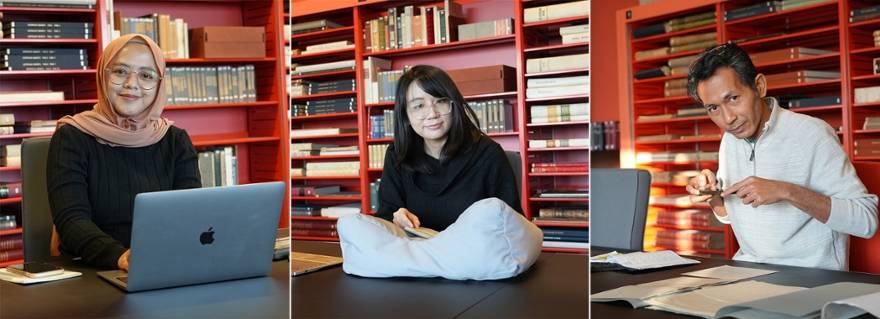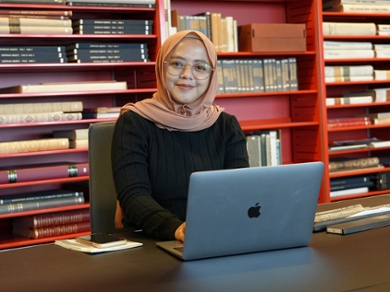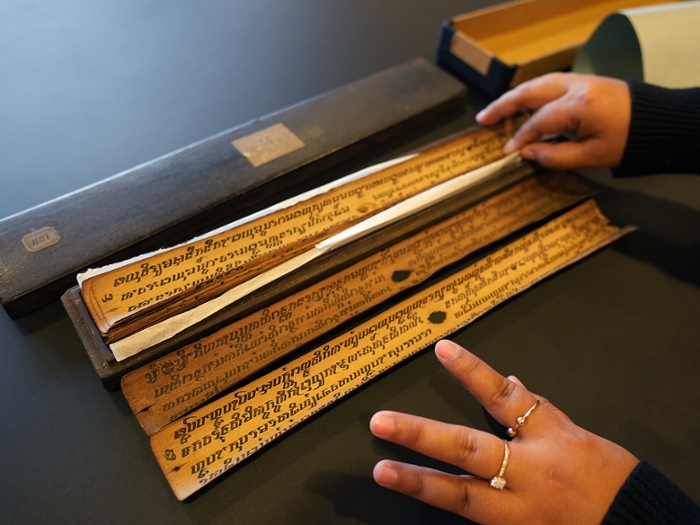
Lingling Wiyadharma Fellows do research in Leiden Special Collections
In November, Leiden University Libraries (UBL) welcomed the first Lingling Wiyadharma Fellows in the Special Collections reading room. Fellows Chin Nyuk Tin, Evi Fuji Fauziyah and Arman AZ are all working on different research projects, yet their goals are the same: building bridges between Southeast Asia and the Netherlands and sharing the knowledge gained during their research in the Special Collections.
The Lingling Wiyadharma Fellowship Program started this year. Every year, it offers three scholars the opportunity to conduct research for three months in Leiden's Southeast Asian, in particular the Indonesian Special Collections. Mr. Hans van der Valk, alumnus of Leiden University, founded the Lingling Wiyadharma Fund in memory of his wife Lingling Wiyadharma, whom he met in the early 1970s when he was a diplomat at the Dutch embassy in Jakarta. The purpose of the fund is to promote and strengthen the use of the Indonesian Special Collections of the UBL among young scholars.

Evi Fuji Fauziyah
Evi Fuji Fauziyah, MA candidate in Philology at Padjadjaran University in Bandung, studies a single manuscript: the Tiga Jñana. Her research is mainly concerned with the accurate transcription and translation of this mystical and philosophical text, written in Old Sudanese.
‘The text is written in Old Sundanese, a language of West Java, and describes every state of human existence. Beginning in the womb, then moving on to existence as we know it on Earth, and ending in the afterlife. The functioning of the human body is described through dozens of gods who control every part of the human body, from eyes to toes, and every bodily function, such as breathing or thinking. Particularly the section on development in the womb is very special in this manuscript. We rarely find such descriptions in other Old Sundanese manuscripts.”
“I started my research by studying photographs of the manuscript, but now that I can see the manuscript up close, I can read Old Sundanese much better. The ‘Nipah’ manuscript, made of thatch palm, is bent in the middle, making it quite challenging to study from scans or photographs. I was very happy that I could come to Leiden to study the manuscript in real life. In that way, the fellowship adds to my research.'


Chin Nyuk Tin
Chin Nyuk Tin, a PhD student at the University of Singapore, is researching Chinese-Malay translations of Chinese texts. Her research focuses on the wave of translations from Chinese to Malay that emerged around the turn of the century among the Peranakan Chinese communities in the Dutch East Indies and the former British trading posts around the Malacca Strait known as the Straits Settlements. The Peranakan Chinese are an ethnic group descendant from early Chinese settlers in the region.
‘Starting at the end of the 19th century, Peranakan Chinese communities in both areas gained an interest in translating both classic and popular Chinese literature to the local Malay language. What I’m trying to find out is why they started to translate these texts. This is quite a difficult question to answer, as different translators had different motivations in different places at different times. Some were trying to educate their communities, others cared more about the cultural impact of Chinese stories. In this sense, the Straits Settlements communities I studied before are different from the ones in the Dutch East Indies. I’m in Leiden to study sources from the Dutch East Indies communities specifically.’
‘The Dutch East Indies Peranakan Chinese communities were more integrated into the local communities but had an aggressive translation movement. More active than we see in the Straits Settlements. I’m trying to investigate the lives of several translators, like Yap Goan Ho and Tan Tek Ho. I’m studying their translations, like the one before me now, but also their publications in the newspapers they worked for, as those might contain clues concerning their ideas about language and culture.’


Arman AZ
Arman AZ is an independent researcher and writer, who is now visiting Leiden for a third time after earlier visits in 2015 and 2018. He is creating a comprehensive catalogue of the Lampung manuscripts in the collection of nineteenth-century linguist Herman Neubronner van der Tuuk. He plans to finish his work this time around, completing a guide to the history of the Lampung language and region for Dutch and Indonesian researchers alike.
‘In essence, I’m a literary writer, which is why I’m always in search of stories. In that search, I started to track historical sources in my home province of Lampung in 2011. That is how I happened upon the name Van der Tuuk for the first time. Nobody there could tell me anything about him, at first. But when I visited the Erasmus House and KITLV Jakarta, I quickly found out that Leiden held a large collection of manuscripts collected by him during his stay in Lampung in 1868. The largest of its kind, in fact. Forgotten poetry, great stories from folklore and, important for my research, the first Lampung-Dutch dictionary. One of my early projects was a documentary about Van der Tuuk and his Lampung dictionary. Shortly after having finished that project, I visited Leiden for the first time. That is when I started work on my catalogue: Catalogue of Lampung Manuscripts in Leiden University Library, which will be published next year. Right now, I'm looking at some important final pieces from the collection, like this letter written by Van der Tuuk himself and a handwritten Lampung alphabet.’
‘I have now almost catalogued the entire collection, and plan to use my time here to do as much analysis and translation as I can. I hope the catalogue can be a guide for future generations of storytellers in the Netherlands and Indonesia, and future linguists. Van der Tuuk’s first-of-their-kind dictionaries for the Bali, Lampung and Batak languages still need to be studied more deeply. There is so much yet to be discovered!’

Lingling Wiyadharma Fellowship
Applications for the Lingling Wiyadharma Fellowship will open at the beginning of 2023.
